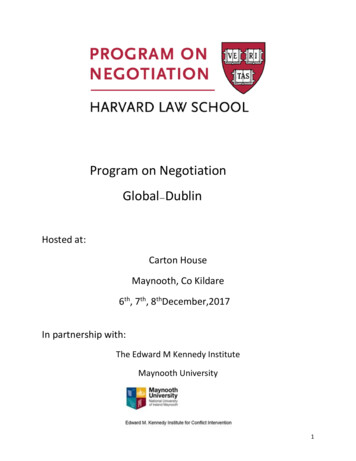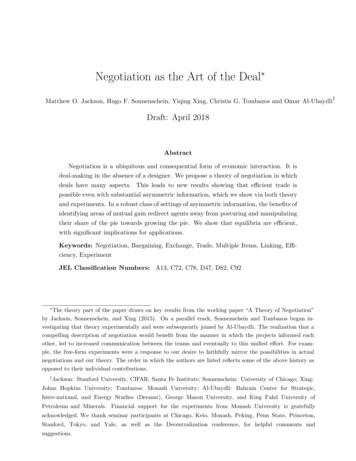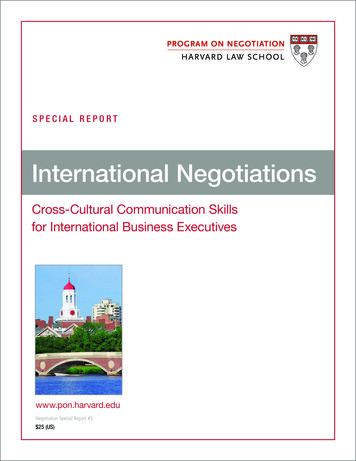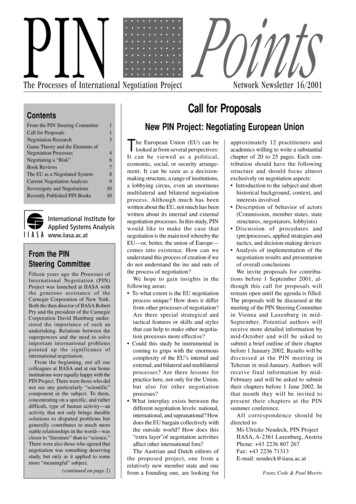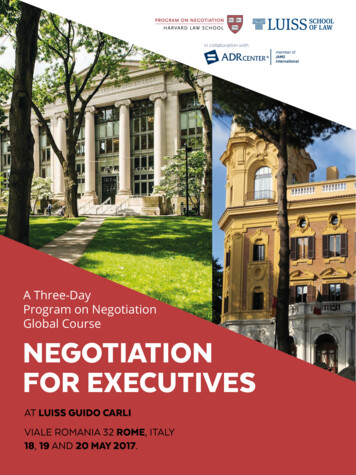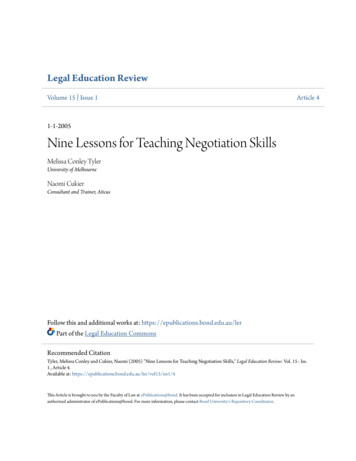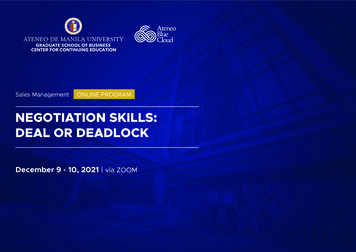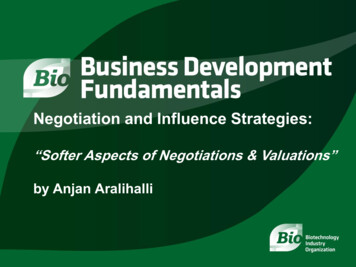
Transcription
Negotiation and Influence Strategies:“Softer Aspects of Negotiations & Valuations”by Anjan Aralihalli
Know Yourself We all have Individual Negotiating StylesCooperativeness(Other Side’s Interests)DominantBehaviorsAssertiveness(Your gGoal: “To find aWin – Win”Goal : “To Win”ModerateCompromisingGoal: “Find a middleground”LowAccommodatingAvoidingGoal: “To Yield”Goal : “To Delay”Based on the Thomas-Kilmann Conflict Mode Instrument (available online).This graph makes the TKI useful to show the tension between value claiming & value creating2
Negotiating StylesEach of us is a blend of styles – we’re not monolithic!Based on the Thomas-Kilmann Conflict Mode Instrument (available online).3
Negotiating Styles Our dominate Negotiating Style is an inherent personal characteristic Unlikely to change much - Can drift with experience / age / situation Need to be mindful of how our Style impacts our negotiations– With those of other Styles– With those of other Status– With those of other Cultures While we can not change our dominate Style, we can develop skills to:– Recognize the Styles of others– Be cognizant of how our Style harmonizes or conflicts withthe Style of others, and thus impacts our negotiations– Be flexible, and moderate or accentuate our Style for optimal results4
What’s your ator?Avoider?5
What’s your ator?Avoider?6
Impact of Negotiating sHighHighModerateCollaboratingGoal: “To find aWin – Win”CompetingGoal : “To Win”May damage relationship“HARD”CompromisingModerateGoal: “Find a middleground”“SOFT”LowLowMay cause too many concessionsAccommodatingAvoidingGoal: “To Yield”Goal : “To Delay”Even as we encourage our students to negotiate in principled and problemsolving ways, a willingness to claim as well as create value is a must forany effective negotiator (Mnookin, Peppet, and Tulumello 2000)7
Beyond Style Negotiation Philosophies?“Positional Negotiations” Positions offers & counter offers (bids) Arguing positions locks parties into thinking that mayresult in less than optimal agreements Arguing positions can take longer- parties may try to several counter-offers beforethey reach an agreement that is satisfactory Arguing positions may hurt the relationship Positional bargaining is even more difficult whenthere are 2 parties8
Beyond Style Negotiation Philosophies?“Principled Negotiations” Use principled negotiations- View participants as problem solvers and not as friends oradversaries- View the goal is achieving a wise outcome efficiently andamicably, not just reaching an agreement "Separate the people from the problem”- "Be soft on the people and hard on the problem" "Focus on interests not positions” "Invent options for mutual gain" Use objective criteria9
Beyond style, all negotiators should . Have the willingness to prepare Have high expectations and self confidenceThere is solid research evidence demonstrating that people who expectmore get more Have commitment to integrity and courtesy Have active questioning and listening skillsMake judicious use of questions, body language, interjections,supportive statements, and clarifying & summarizing statements toelicit information10
Video11
Negotiator’s ToolboxInfluencePersuasionNegotiationNEGOTIATION12 REFERENCE: Mario Moussa Personal Slides
Outline1. How People Think2. Irrational Decision-Making?3. Common Negotiation Biases4. Persuasion5. Non-Verbal Communication13
How People Think S1 Vs. S2 Illusions & Intuition14
S1 Vs. S2 Thinking15
S1 Vs. S2 Thinking Two systems of thinking: S1 & S2 or Intuitive Versus Deliberate S1 (Automatic)S2 (Reflective)– Uncontrolled- Controlled– Effortless- Effortful– Associative- Deductive– Fast- Slow– Unconscious- Self-aware– Skilled- Rule-following– Gut reaction- Conscious thought– Answer 2 2 - Telling someone your phone number S1 often takes over when negotiators face intense time pressure. S1 fine for simple tasks but S2 critical for complex negotiations.16REFERENCE:When Not to Trust Your Gut, Bazerman & Malhotra, July 31, 2006, HBS,Working Knowledge for Business LeadersNudge, Thaler & Sunstein, Yale U. Press, 2008 (Pages 19-20)
Mind can be easily fooled – illusions.Example17
What about trusting our Intuition?6 Illusions On How Our Intuition Deceives Us:1) Illusion of Attention2) Illusion of Memory3) Illusion of Confidence4) Illusion of Knowledge5) Illusion of Cause6) Illusion of Potential Lots of debate. Flavor of ice cream versus a mutual fund. Key to successful decision-making isknowing when to trust your intuition andwhen to be wary of it.18
Irrational Decision-Making Asch Experiments Economist Example Inattentional Blindness Are Humans Rational?19
Conformity In Groups20 REFERENCE: t.html
Conformity In Groups Solomon Asch Experiments (1950s) Showed how perfectly normal human beings can be pressuredinto unusual behavior by authority figures, or by theconsensus of opinion around them.– Done individually – easy task, all correct– When group makes error, sways your choice– Why? Info conveyed by people’s answers and desire not toface disapproval of group– Less conformity when people are asked to give anonymousanswers. Subsequent MRI studies – peer pressure can alter how peoplesee the lines (people do not consciously deliberate).21REFERENCE:Nudge, Thaler & Sunstein, Yale U. Press, 2008 (Pages 56-59)The Science of Subtle Signals, Mark Buchanan, Strategy & Business, Issue 48, Autumn 2007,Booz Allen Hamilton
Conformity In Groups The principle of independent judgments has immediateapplications for the conduct of meetings – before an issue isdiscussed, all members of the committee should be asked towrite a very brief summary of their position. This procedure makes good use of the value of the diversity ofknowledge and opinion in the group. The standard practice of open discussion gives too muchweight to the opinions of those who speak early andassertively, causing others to line up behind them.22REFERENCE:Nudge, Thaler & Sunstein, Yale U. Press, 2008 (Pages 56-59)The Science of Subtle Signals, Mark Buchanan, Strategy & Business, Issue 48, Autumn 2007,Booz Allen Hamilton
The Economist Example (Video)Framing & Contrast Principle23
Framing & Contrast (WSJ Ad)24
Inattentional Blindness (Video)25
Inattentional Blindness These videos illustrate two important facts: We can be blind to the obvious We are also blind to our blindness26 REFERENCE:
Are Humans Rational? Traditional Economist – taught that each of us thinks andchooses unfailingly well (rational).– Efficient market hypothesis questioned after stock marketbubble in 1990s/early 2000’s. Research has raised serious questions about the rationality ofmany judgments and decisions that people make. So in other words .27
Traditional Economist’s View of Humans28
Behavioral Economist’s View of Humans29
Common Negotiation Biases 30AnchoringOverconfidence Bias/Competitor NeglectRisk & Loss Aversion/Risk SeekingFairness (Ultimatum Game)
Anchoring Process of subconsciously influencing someone's thinking by dropping anumber as a reference point. 2 groups of students asked percentage ofcountries in the UN were in Africa.In each group, roulette wheel spun. 1st group, wheel landed on 10 & participantsasked if they believed percentage was higher or lower than 10%. Mostthought it was higher. 2nd group's wheel landed on 65 & same question was asked. Most thoughtlower. A discussion ensued and both groups were asked to make estimates .31 REFERENCE: Tversky, A. & Kahneman, D. (1974). Judgment under uncertainty: Heuristics and biases. Science, 185, 1124-1130.Retrieved from "http://en.wikipedia.org/wiki/Anchoring"
Anchoring . Mean estimates: 1st group (wheel landed on 10) was 24% 2nd group (wheel landed on 65) was 45%. Estimates strongly anchored by the roulette wheel's results,even though students all witnessed how completely arbitrarythese starting points were. 192 member countries in the UN 50 countries in Africa (maximum is 26%)32 REFERENCE: Tversky, A. & Kahneman, D. (1974). Judgment under uncertainty: Heuristics and biases. Science, 185, 1124-1130.Retrieved from "http://en.wikipedia.org/wiki/Anchoring"
Using the Power of AnchoringAnchoring (Playing Offense)1. Set high goals prior to negotiation; those with high & measurable goalsconsistently outperform those that set more modest goals.2. Open with the highest (lowest) number for which there is a supportingstandard or argument enabling you to make a presentable case.Anchoring (Playing Defense)1. Use Inside “de-biasing” strategy – negotiator should consider theopposite perspective before deciding whether or not to accept an offer.2. Use Outside “de-biasing strategy – effectively ignore the details of thecase at hand & conduct an analysis of a number of analogous cases.Remember to consider how much information the other party has aboutwhat is being negotiated (asymmetrical/symmetrical) & how experiencedthey are.33REFERENCE: Anchoring, Information, Expertise & Negotiation: New Insights from Meta-Analysis, Orr & Guthries, Ohio State Journal on Dispute ResolutionVolume 21, Number 3, 2006, Pages 606-608
Overconfidence Bias & Competitor NeglectIllusion of Confidence & Knowledge 63-70% of people rate themselves as above average in intelligence 90% of students rated themselves better than the average driver Investor’s Assistance Program – 70% of inventions given failure grade; 50%of inventors persisted in spite of objective advice. Only 5/411 projectsgiven failure grade were commercialized and none successful. Key factor in outcome of business initiative is competitor’s behavior butexecutives tend to focus on own company’s capabilities & plans. They often neglect the potential abilities and actions of rivals – results isan underestimation of the potential for negative events.34REFERENCE:Cooper, Woo & Dunkelberg, Entrepreneurs Perceived Chances for Success, Journal of Business Venturing 3(2), 737-770 (1988) – Courtesy Guhan Subramanian (HBS)The Invisible Gorilla, Chabris & Simons, Crown Publishers, 2010, Page 93Thinking Fast And Slow, Daniel Kahneman (Farrar, Straus & Giroux/New York, 2011)
Risk Aversion Investor is a risk-seeker when faced with the prospect oflosses, but is risk-averse when faced with the prospects ofenjoying gains. Kahneman and Tversky, 1979 offered subjects followingoptions to choose from:a) 80% of winning 4,000 with 20% of winning nothingb) 100% of receiving 3,000. Subjects chose (?).35 REFERENCE: Hersh Shefrin, Santa Clara University, Behavioral Corporate Finance White Paper
Loss Aversion/Risk Seeking Then, the following options were given:a) 80% of losing 4,000 & 20% of losing nothingb) 100% of losing 3,000. Subjects predominantly chose (?). When faced with the prospect of a loss, individuals becomerisk-seeking – take the 20% chance!36 REFERENCE: Hersh Shefrin, Santa Clara University, Behavioral Corporate Finance White Paper
The Bogeyman: Risk Aversion in the PGA Professors Schweitzer & Pope (Wharton) analyzed 1.6MM putts from 200 pros.Birdie putts were made about 3% less often that otherwise identical par putts.Tendency existed regardless of skill, round or hole number, putt length, etc.Pros certainly do not make a conscious decision to slack off on birdie putts but their intense aversionto a bogey apparently contributes to extra concentration on the task at hand.Reinforces the psychological preference to avoid a perceived penalty (losing a stroke relative to par)rather than going for a perceived gain (gaining a stroke).REFERENCE: udy.html37 Thinking Fast And Slow, Daniel Kahneman (Farrar, Straus & Giroux/New York, 2011)
Loss Aversion/Risk SeekingProspect Theory (Kahneman & Tversky) Scenario 1: Find a 20 bill Scenario 2: Find 10 bill; next day find another 10 bill Scenario 1: Lose 20 Scenario 2: Lose 10 bill; next day lose another 10 bill We seem to prefer gaining money in installments but losing money in onelump sum. Impact of a loss is 2 to 2.5 X that of a gain. Give good news in chunks and bad news all at once! Frame choices in terms of losses rather than gains.38REFERENCE: Negotiation Newsletter, PON, Harvard Law School, Volume 10 (8), Aug 2007 Malhotra & Bazerman
Risk Assessment of CEO VS BU Heads Top managers of 25 divisions of a large company were asked whichwith equal probabilities, could lose a large amount of capital theycontrolled or earn double that amount – none of the executiveswas willing to take such a dangerous gamble. When CEO was asked same question – “I would like all of them toaccept their risks.” It was natural for the CEO to adopt a broad frame thatencompassed all 25 bets. If all 25 bet 1MM ( 12.5MM lost but 25MM gained).39 REFERENCE: Thinking Fast And Slow, Daniel Kahneman (Farrar, Straus & Giroux/New York, 2011)
Fairness (Ultimatum Game) Allocator has been given 10 to share with Recipient whom hedoes not know. If R refuses A’s offer, neither player will receive anything. Rational acceptable offer would be 0.01 (Spock)– A penny is better than nothing? Experiments found mean acceptable offer varied 2 - 2.59.40 REFERENCES: Anomalies: The Ultimatum Game (Thaler, J of Economic Perspectives V 2, No 4, 1988, 195-206)
Fairness (Ultimatum Game) Experiment repeated in many countries & cultures & usinghigher amounts. Recipient will actually punish any unfair division. Conclusion: Notions of fairness can play a significant role indetermining the outcomes of negotiations.41 REFERENCES: Anomalies: The Ultimatum Game (Thaler, J of Economic Perspectives V 2, No 4, 1988, 195-206)
Many Decision-Making BiasesGet an Outsider’s Perspective Decision-making and behavioral biasesMany of these biases are studied for how they affect belief formation and business decisions and scientific research.Bandwagon effect — the tendency to do (or believe) things because many other people do (or believe) the same. Related to groupthink, herd behaviour, and manias.Base rate fallacyBias blind spot — the tendency not to compensate for one's own cognitive biases.Choice-supportive bias — the tendency to remember one's choices as better than they actually were.Confirmation bias — the tendency to search for or interpret information in a way that confirms one's preconceptions.Congruence bias — the tendency to test hypotheses exclusively through direct testing, in contrast to tests of possible alternative hypotheses.Contrast effect — the enhancement or diminishment of a weight or other measurement when compared with recently observed contrasting object.Déformation professionnelle — the tendency to look at things according to the conventions of one's own profession, forgetting any broader point of view.Endowment effect — "the fact that people often demand much more to give up an object than they would be willing to pay to acquire it".[1]Extreme aversion — the tendency to avoid extremes, being more likely to choose an option if it is the intermediate choice.Focusing effect — prediction bias occurring when people place too much importance on one aspect of an event; causes error in accurately predicting the utility of a future outcome.Framing — by using a too narrow approach or description of the situation or issue.Hyperbolic discounting — the tendency for people to have a stronger preference for more immediate payoffs relative to later payoffs, the closer to the present both payoffs are.Illusion of control — the tendency for human beings to believe they can control or at least influence outcomes that they clearly cannot.Impact bias — the tendency for people to overestimate the length or the intensity of the impact of future feeling states.Information bias — the tendency to seek information even when it cannot affect action.Irrational escalation — the tendency to make irrational decisions based upon rational decisions in the past or to justify actions already taken.Loss aversion — "the disutility of giving up an object is greater than the utility associated with acquiring it".[2] (see also sunk cost effects and Endowment effect).Mere exposure effect — the tendency for people to express undue liking for things merely because they are familiar with them.Need for closure — the need to reach a veredict in important matters; to have an answer and to escape the feeling of doubt and uncertainty. The personal context (time or socialpressure) might increase this bias.[3]Neglect of probability — the tendency to completely disregard probability when making a decision under uncertainty.Omission bias — The tendency to judge harmful actions as worse, or less moral, than equally harmful omissions (inactions).Outcome bias — the tendency to judge a decision by its eventual outcome instead of based on the quality of the decision at the time it was made.Planning fallacy — the tendency to underestimate task-completion times.Post-purchase rationalization — the tendency to persuade oneself through rational argument that a purchase was a good value.Pseudocertainty effect — the tendency to make risk-averse choices if the expected outcome is positive, but make risk-seeking choices to avoid negative outcomes.Reactance - the urge to do the opposite of what someone wants you to do out of a need to resist a perceived attempt to constrain your freedom of choice.Selective perception — the tendency for expectations to affect perception.Status quo bias — the tendency for people to like things to stay relatively the same (see also Loss aversion and Endowment effect).[4]Unit bias — the tendency to want to finish a given unit of a task or an item with strong effects on the consumption of food in particularVon Restorff effect — the tendency for an item that "stands out like a sore thumb" to be more likely to be remembered than other items.Zero-risk bias — preference for reducing a small risk to zero over a greater reduction in a larger risk.42 REFERENCE : Wikipedia search “Decision-Making Biases”
Persuasion Nudges Choice Architecture Amsterdam Airport Menu or Food Placement Defaults – Organ Donations Persuasion Tools43
What is a “Nudge”? R. Thaler (U of Chicago) & C. Sunstein (Harvard – on leave) “Everything matters” – small and apparently insignificant details canhave major impacts on people’s behavior. Choice Architect: has the responsibility for organizing the context inwhich people make decisions. Nudge: any aspect of choice architecture that alters people’s behaviorin a predictable way without forbidding any options or significantlychanging their economic incentives.– Intervention must be easy and not mandated (e.g., fruit at eye levelvs. banning junkfood)44 REFERENCE: Nudge, Thaler & Sunstein, Yale U. Press 2008
Amsterdam (Schipol) Airport45
Amsterdam (Schipol) Airport46
La Cage Aux Sports Restaurant (Montreal, Canada)47
Choice Architecture Health Eating48
Organ Donations Example (Video)Status Quo Bias/Default Option49
Nudges Review Humans are imperfect! Status quo bias (keep status quo or default – e.g., organdonations) Nudges can improve decision-making without restrictingchoices. Nudges are one example of influencing or persuading.50 REFERENCE: Nudge, Thaler & Sunstein, Yale U. Press 2008
Six Principles of InfluenceREFERENCE: Influence: Science & Practice, Robert Cialdini, Pearson Education, 200951
Influence: Six Major Principles1. Reciprocity – You, then me, then you, then me .–Be the first to give service, information, concessions during negotiation.2. Liking – Making friends to influence people.–Uncover similarities, areas for genuine compliments & cooperation.3. Consensus – People follow the lead of similar others-Show others’ responses, past successes, testimonials.4. Consistency – People fulfill written, public, voluntarycommitments. Petitions are a good example.5. Authority – People defer to experts who provide shortcuts todecisions requiring specialized information.6. Scarcity – People value what is scarce–Emphasize genuine scarcity, unique features, exclusive informationREFERENCE: Influence: Science & Practice, Robert Cialdini,Pearson Education, 200952
Authority“Outside Experts/KOLs/BoD/SAB” Blind Obedience– Airline Captains, Doctors & Nurses Best authority has both knowledge (expertise and background) &trustworthiness. Effective use of authority is often accompanied by: independent justifications & explanations Candidate for Governor video– Pleads case using authority53 REFERENCE: Influence: Science & Practice, Robert Cialdini, Pearson Education, 2009
Candidate for Governor’s TelevisedSpeech (Video)54
Non-Verbal Communication Facial Expressions & Body Language “Honest Signals” Communication Medium Deception“The most important thing in communicationis hearing what isn’t said.”- Peter F. Drucker55
Facial Expression/Body LanguageExample 56Alex Rodriguez interview with Katie Couric in 2007 where denied steroid use.Feb 2009, Rodriguez admitted to steroid use. Interview was heavily analyzed.Several signals that suggest Rodriguez may have been hiding something/lying.Not a perfect science.REFERENCE: arsh.html
Non-Verbal Communication Significance Human language may be as little as 50,000 years old.– Prior, we still had ability to hunt, move and survive as teams. What is percentage of communication expressed non-verbally?– Plenty of debate on subject.– “More than you think but less than what you’ve heard.” Students responded very positively to teachers:– Eye contact, affirmative head nods, leaning forward & smiling Dr. John Gottman can predict with 90% accuracy whether acouple will get divorced based on (among other variables) bodylanguage and communication style during a 15 min conversation.57REFERENCE:The Science of Subtle Signals, Mark Buchanan, Strategy & Business, Issue 48, Autumn 2007, Booz Allen HamiltonBlink, Malcolm Gladwell , Back Bay Books, Little, Brown & Company, 2005, Page 20-33
Communication MediumHow to Negotiate When You’re Far Apart (Literally) Email, Phone Call or Take a Flight? Globalization offers many new opportunities but time & higher costs oftravel force more negotiations to go “on-line”. Choice of communication medium affects:– Quality of relationship, amount of information shared & efficiency ofnegotiated agreement. Telephone and written negotiations are more likely to result in impasse &less joint gains than negotiations conducted FTF. Cooperation/rapport decreases as richness of media decreases.58REFERENCE:How to Negotiatate When You’re Far Apart, Swaab & Galinsky, Negotiation Newsletter, February 2007Paese, Schreiber & Taylor, Group Decision & Negotiation 12: 537-566, 2003
“Road Rage” Video ClipImportance of FTF!59
Deception During Negotiation Why is it common?– Hope of improving own short-term outcomes at expense of counterpart– Little choice but to rely on data & claims by other party.– Studies have shown most people lie at least once during a 10 minconversation– One study showed that people conversing by email told 5X as many lies aspeople speaking FTF. Emailed lies typically more self-serving.– People in general want to be honest but are also tempted to benefit fromdishonesty.– As long as we cheat only a little bit, we can benefit from cheating and stillview ourselves as marvelous human beings.– Dishonesty/cheating does not vary much between countries.– Cheating can be infectious60REFERENCE: Negotiators Lie, Maurice E. Schweitzer, Negotiation Newsletter, Dec 2005“Email Hides Your Lying Eyes”, Harvard Business Review, April 2012 (28)The (Honest) Truth About Dishonesty, Dan Ariely, Harper, June 2012
Deception During Negotiation Don’t be afraid to be honest!– Honest disclosure elicits cooperation - causes other side to trust discloser.– Trusting atmosphere frees negotiator from having to guard againstcompetitive tactics.– Environment allows the negotiator to make less defensive/ demandingoffers that, in turn, lead to faster & more efficient resolution.61REFERENCE: Negotiators Lie, Maurice E. Schweitzer, Negotiation Newsletter, Dec 2005“Email Hides Your Lying Eyes”, Harvard Business Review, April 2012 (28)
Discouraging Deception1.2.3.4.5.6.7.Assure your counterpart they will meet their goals.Convince your counterpart that they are making progress.Point out how your goals & your counterpart’s are linked.Suggest that your counterpart has limited alternatives to the current deal.Imply that you have strong outside alternatives .Point out shared social identities (age, job history, marital status, etc.)Encourage your counterpart to identify with an ethical organization such ashis/her trade group.8. Note that your connections to your counterpart’s social network.9. Suggest long-term business opportunities you might offer.10. Remind your counterpart of the legal implications of unethical behavior.11. Mention the prospect of future personal or social support.12. Propose becoming a gateway to valued social or business networks.62REFERENCE:Negotiation Briefings, Volume 17, Number 6, June 2014 (Harvard Law School) from Neutralizing Unethical Negotiating Tactics: An Empirical Investigation ofApproach Selection & Effectiveness” by Fleck, Volkema, Pereira, Levy & Vaccari in Negotiation Journal (January 2014)
A Word About Women in Negotiations63
Women in Negotiations (Continued) Average college-educated woman earns 713,000 less over the course of her workinglife than her male counterpart.Women feel there is a “Social Cost to Negotiation” – feel they will be perceived as“pushy” or “demanding” vs. a male counterpart demanding the same thing.Women negotiate much better on behalf of others than themselves, often exceedingmen – they feel they will not be penalized for negotiating forcefully for someone else.Outgoing, well-connected, successful venture capitalist–– Howard was judged pleasant to work withHeidi was judged to be selfish and an unappealing colleagueThink I, Talk We – Women should try to link aggressive demands to the needs ofothers, such as the organization’s. Requests made on others’ behalf are likely to bebetter received.“I know that the company would not want a subordinate to be paid more than asupervisor. I’m sure you agree that we should correct this.” Use Objective Measures – When making requests, women should reference relevantstandards that would be difficult for the other side to ignore.64
Women in Negotiations (Continued) Women receive psychological lift from feeling powerful thatmotivates them to negotiate more forcefully for themselves indistributive negotiations (single-issue) Women primed to feel powerful (“High Power” condition) mademuch more aggressive first offers & negotiated better outcomesfor themselves than women in control condition. Men reachedsimilar outcomes whether or not they were primed. Focus on skills: can gain confidence & overcome stereotypes byviewing negotiation as a skill that can be improved with practiceas opposed to a stable personality trait.65
A Word About Cross-Culture Negotiations Better understanding of cultural differences can improve our ability tounderstand & work more effectively with counterparts from other cultures. Cultural differences often spring from our different histories includingpopulation density and type of economy. Researchers recently categorized world’s cultures into 3 prototypes:– Dignity, Face, Honor Dignity Cultures––––––Developed in societies built on agriculture with low population densityIncludes US, Canada & Northern EuropeTend to prize independence & free will rather than a reliance on othersStrive to manage conflict rationally & directly while avoiding strong emotional reactionsBecause typically supported by strong markets & effective system of law, more trustPrefer a collaborative approach to negotiation; explore mutual interests & priorities via Q&AREFERENCE:Negotiation Briefings, Volume 17, Number 6, June 2014 (Harvard Law School) from research published by Aslani, Ramirez-Marin, Semnani-Azad, Brett &66Tinsley in Handbook of Research in Negotiation (Edward Elgar, 2013)
Cross-Culture Negotiations (Continued) Face Cultures––––Found primarily in East Asian societies (China, Japan)Sprang up in agricultural regions with rapidly growing populationsReputation for social responsibility & great respect for elders and traditionsCultural norms encourage people to save face & preserve harmony by avoiding directconfrontation, suprressing negative emotions & deferring to authority– Lack of trust leads to an indirect approach to explore other side’s interests– May achieve more by exchanging offers & backing them up vs. directly trading info aboutpriorities & preferences Honor Cultures–––––––Sprang up in regions with herding economies & low population densityIncludes Middle East, North Africa, Latin America & parts of Southern EuropeHerds were vulnerable to poachers thus traits promoting theft deterrence became prevalentStrong defense of oneself & one’s family, reliance on code of honor & close family tiesView insults & other conflicts as direct challenges to their status & can respond boldlyBetrayal Aversion – reluctant to trust for fear of being betrayed; more negative emotionsImportant to spend time building trust & managing conflictREFERENCE:Negotiation Briefings, Volume 17, Number 6, June 2014 (Harvard Law School) from research published by Aslani, Ramirez-Marin, Semnani-Azad, Brett &67Tinsley in Handbook of Research in Negotiation (Edward Elgar, 2013)
Cross-Culture Negoti
Negotiating Styles Our dominate Negotiating Style is an inherent personal characteristic Unlikely to change much - Can drift with experience / age / situation Need to be mindful of how our Style impacts our negotiations –With those of other Styles
